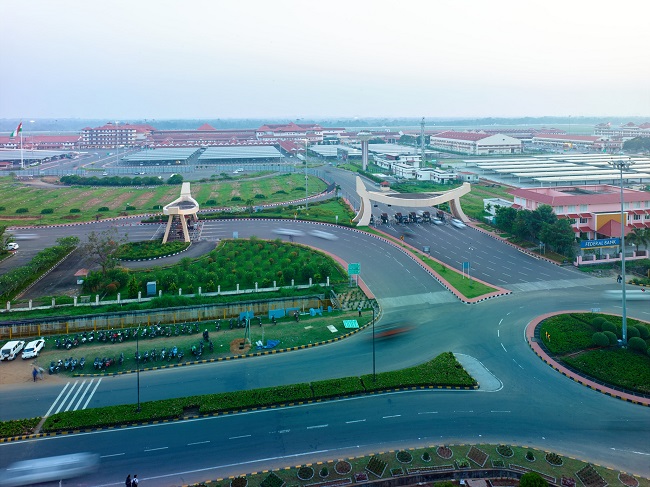Cochin International Airport Ltd. (CIAL) today marked a significant leap into the future with the grand launch of CIAL 2.0, a transformative initiative poised to fully digitize airport operations and elevate the passenger experience through cutting-edge artificial intelligence, advanced automation, and robust cybersecurity measures. Kerala’s Chief Minister and Chairman of CIAL, Shri Pinarayi Vijayan, inaugurated the ₹200-crore project at 5 PM at the CIAL Trade Fair & Exhibition Centre.
During the launch, Chief Minister Vijayan underscored the paramount importance of ensuring the utmost safety for air travelers and safeguarding airport assets. He highlighted that the CIAL 2.0 project meticulously integrates various initiatives centered on artificial intelligence, automation, and impregnable cybersecurity, all designed to address emerging challenges in the digital landscape and significantly enhance the overall travel experience. He noted that CIAL is on its way to becoming an entirely digital airport.


S. Suhas IAS, Managing Director of CIAL, articulated the vision behind CIAL 2.0, stating, “Cochin International Airport is embracing the future with CIAL 2.0 – a visionary leap into digital transformation that places intelligence at the heart of every operation. These projects, envisioned under the guidance of our esteemed Chairman and Board of Directors, represent a holistic upgrade of CIAL’s digital backbone. This includes fortifying digital infrastructure, enhancing security and operational efficiency, introducing next-generation security systems, and improving passenger convenience through AI-driven solutions.”
At the core of this transformation is the newly established Cyber Defence Operations Centre (CDOC), a state-of-the-art facility dedicated to proactively protecting digital infrastructure. This pioneering, full-fledged on-premises server facility, supported by CDAC, is the first of its kind at an Indian airport. It boasts real-time threat intelligence, continuous 24×7 monitoring, and rapid incident response capabilities. Given the rising cyber threats in the aviation sector, the CDOC employs advanced security tools to detect, neutralize, and preempt external threats such as hacking attempts, malware intrusions, and ransomware attacks. This real-time digital shield guarantees that CIAL’s extensive network and IT infrastructure remain resilient, uninterrupted, and highly secure, setting a national benchmark in airport cybersecurity.
Passenger security and convenience are also being revolutionized. The introduction of full-body scanners promises fast, contactless, and non-intrusive passenger screening, aligning with international standards. These enhancements ensure seamless yet thorough security checks without compromising traveler comfort. Furthermore, the deployment of an Automated Tray Retrieval System (ATRS) at security checkpoints will significantly improve processing speed and passenger convenience. This system automates the movement of security trays, reducing manual handling and substantially accelerating cabin baggage screening.
Airport and perimeter security are being fortified with a powerful, AI-driven surveillance network. Over 4,000 intelligent cameras are now actively monitoring terminal interiors, airside zones, and other sensitive areas. These AI-powered systems utilize deep learning for sophisticated behavior analysis, real-time threat detection, and swift response, leading to a quantum leap in security precision and situational awareness, ensuring a safe environment for all. The Next-Gen Security Infrastructure is further bolstered with advanced tools, including a Bomb Detection and Disposal System (BDDS) featuring new liquid explosive detectors, portable X-ray devices, and Threat Containment Vessels (TCV) for safe handling of high-risk materials.


The airport’s digital backbone has undergone comprehensive Core System Modernisation. This includes a revamped Airport Operational Database (AODB), Flight Information Display System (FIDS), and Automatic Flight Announcement System. CIAL has also introduced Common Use Passenger Processing Systems (CUPPS), allowing flexible, shared-use counters for airlines. A next-generation Data Centre, based on Hyper-Converged Infrastructure (HCI), now offers scalable and secure backend support, complemented by an upgraded network infrastructure ensuring high-speed and fail-safe connectivity across all airport operations.
CIAL 2.0 also introduces an Innovation Suite of smart digital services aimed at redefining convenience and automation for the modern traveler. These include facial recognition check-in, AI-based baggage tracking, a ‘FindMe’ lost item tracker, prepaid cab booking kiosks, and seamless integration with Bar-Coded Boarding Pass (BCBP) and DigiYatra.
Coinciding with the launch of CIAL 2.0, the Aero Digital Summit is being held from 2:30 PM to 8:30 PM at the same venue. The summit is showcasing live demonstrations of the new IT infrastructure, featuring mini humanoid robots and robotic dogs, engaging virtual reality gaming experiences, a heart stepper activity, and an automated industrial assembly line. The summit will conclude with a insightful panel discussion on the “Future of Technology & Innovation in Airports,” bringing together thought leaders and experts from the industry.
